Guruvayoor Sree Krishna temple in Kerala - The Holy Abode of Lord Sree Krishna
Guruvayoor Sree Krishna temple is a very popular religious place in Kerala located near Thrissur district. It is the holy abode of Lord Krishna who is the avatar of Lord Mahavishnu. Read this article to know all the information about Guruvayoor temple including the history, dress code, festivals, rituals, darshans, official website and address of the temple.
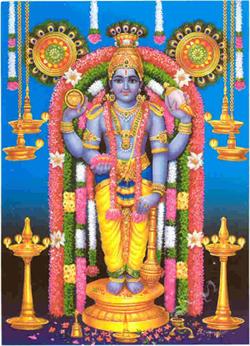
Guruvayoor Sree Krishna Temple is a very famous temple situated in Thrissur district of Kerala. It is located about 80 km from Cochin and 33km north of Thrissur. Hindu keralites consider this temple as the most sacred temples of all. The main deity of this temple is Lord Krishna also known as Guruvayoorappan. As Lord Krishna is an avatar of Lord Mahavishnu, the idol placed as the main deity in the temple is a four-armed Lord Vishnu. The four arms of Mahavishnu carry the conch Panchajanya, the discus Sudarshana Chakra, the mace Kaumodaki and the lotus. Some of the important festivals celebrated in Guruvayoor temple include Janmashtami, Kumbham Utsavam and Ekadasi. People from all over India travel specifically to worship the lord at Guruvayoor temple. It is said that the temple is at least 1000 years old. The temple is governed by the Guruvayoor Devaswom board committee who maintains its administration. Almost every day of the year, regardless of whether it is a weekday or weekend, the temple is always crowded and people wait in long queues to receive a darshan of the lord. Only Hindus are allowed into the premises of Guruvayoor temple. Photography is strictly prohibited inside the temple.
The idol of Mahavishnu is made of a particular stone called 'pathalanjana sila' which is a magnetic stone having medicinal properties. The life of Lord Krishna is depicted through mural paintings of the 17th century which fill the inner space of the shrine and roofs. The two doors of the entrance towards the shrine is covered with gold. The other shrines that are placed in Guruvayoor temple are Goddess Durga, Lord Ganapathi, Lord Ayyappan each of them facing a different direction.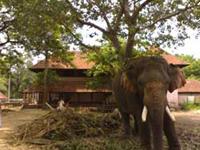 There is an elephant sanctuary near Guruvayoor temple which is home to about 50 elephants that are gifted by devotees as an offering to the lord. The sanctuary is located at Punnathur Kotta which is about 3kms north of Guruvayoor temple.
There is an elephant sanctuary near Guruvayoor temple which is home to about 50 elephants that are gifted by devotees as an offering to the lord. The sanctuary is located at Punnathur Kotta which is about 3kms north of Guruvayoor temple.
The temple is also referred to as 'Bhooloka Vaikuntam' as it is the holy abode of Lord Vishnu. Guruvayoor temple is also known as the Dwaraka of the South. Some of the other names by which Sree Krishna is referred are Kannan, Unni-Kannan, Unnikrishnan and Balakrishnan. The festival Utsavam is celebrated with a lot of enthusiasm in Guruvayoor and is a major attraction which is celebrated in the months of February or March.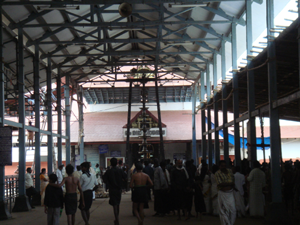 The structure of this historic temple is of typical Kerala style architecture with gopurams (gateways), mandapams, sreekovil and subsidiary shrines around a courtyard. The main entrance of the shrine lies in the eastern gopuram of the temple. No compromise is made in the rituals and poojas of the temple and are strictly followed as per the schedule. The Chennas Namboodiris are the hereditary Tantris of Guruvayoor temple. Many people believe in the healing powers of Lord Sree Krishna who resides here and there are also many superstitions connected to it. Devotees arrive daily to pa their offerings and conduct some poojas.
The structure of this historic temple is of typical Kerala style architecture with gopurams (gateways), mandapams, sreekovil and subsidiary shrines around a courtyard. The main entrance of the shrine lies in the eastern gopuram of the temple. No compromise is made in the rituals and poojas of the temple and are strictly followed as per the schedule. The Chennas Namboodiris are the hereditary Tantris of Guruvayoor temple. Many people believe in the healing powers of Lord Sree Krishna who resides here and there are also many superstitions connected to it. Devotees arrive daily to pa their offerings and conduct some poojas. Programmes conducted at Guruvayoor temple
Marriages also take place in this temple. During the weekends, the place is filled with people who are associated with the bride and bridegroom. It is the sacred ceremony of tying the mangalsutra or thaalikettu that takes place mainly in Guruvayoor temple. To avoid the crowds, some brides and bridegrooms come early in the morning to tie the knot (thaali) and then return to their respective places to conduct the rest of the marriage ceremony in some marriage hall at their native place.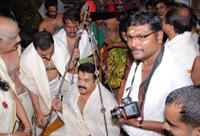 All the temple poojas and rituals are performed in Guruvayoor temple, right from the simple 'archana' (an offering of flowers) to the elaborate udayastamana pooja. Another famous offering that takes place in this temple is 'Thulabharam' which is a ceremony wherein the devotee sits on one side of the weighing balance and is weighed against bananas, sugar, jaggery, coconuts or any item in bulk which the devotee brings from home and wishes to offer for any wish that has been granted or wishes to fulfil. The devotee prays to the lord while being weighed. After the Thulabharam, the item is then gifted to the temple. The temple also conducts 'annaprasanam' also known as 'choroonu', the first feeding ceremony of a child. Many strong devotees take an oath that they would give their child's official first feeding only at Guruvayoor temple.
All the temple poojas and rituals are performed in Guruvayoor temple, right from the simple 'archana' (an offering of flowers) to the elaborate udayastamana pooja. Another famous offering that takes place in this temple is 'Thulabharam' which is a ceremony wherein the devotee sits on one side of the weighing balance and is weighed against bananas, sugar, jaggery, coconuts or any item in bulk which the devotee brings from home and wishes to offer for any wish that has been granted or wishes to fulfil. The devotee prays to the lord while being weighed. After the Thulabharam, the item is then gifted to the temple. The temple also conducts 'annaprasanam' also known as 'choroonu', the first feeding ceremony of a child. Many strong devotees take an oath that they would give their child's official first feeding only at Guruvayoor temple.Rituals and darshans at Guruvayoor temple
The Chief Priest also known as Melshanti enters the Sree Kovil at 2.30am and conducts all the poojas till 12.30 noon without even drinking a glass of water. It is this perfection and faithfulness that makes the temple very unique and powerful of all the temples. Guruvayoor temple opens to the beats of the Nadaswaram for the Nirmalayam darshan. During this time, devotees chant 'Narayana, Narayana' till the main darshan is over.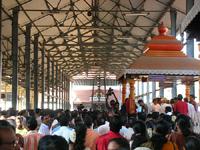 When the doors open to the shrine for darshan, the Lord Krishna would be still adorned with the flowers and tulasi garlands of the previous day. The Lord is then smeared with til oil and sprinkled with a powder called 'vaka' which is a special cleansing powder made of herbs. It is during the darshan that the idol is bathed with the water taken from the temple and dressed again as Balagopala or child version of Lord Krishna. This holy water is also distributed to the devotees who drink it with zest as it is believed to contain a small part of the special healing stone that is used to make the idol. Mantras are chanted all the while by the melshanti, devotees and every other person present there. The special powder gives a bright colour to the idol and the sight of the adorned idol is simply charming. The 'uchcha' (afternoon) pooja takes place at mid day. The temple then closes after noon till 4pm. After the temple opens in the evening at 4, it is a continuous series of poojas, rituals and chants till the temple closes at 10 in the night. In the evening, the opening of the doors to worship the lord is called as 'Deeparadhana' for which the idol is elaborately decorated.
When the doors open to the shrine for darshan, the Lord Krishna would be still adorned with the flowers and tulasi garlands of the previous day. The Lord is then smeared with til oil and sprinkled with a powder called 'vaka' which is a special cleansing powder made of herbs. It is during the darshan that the idol is bathed with the water taken from the temple and dressed again as Balagopala or child version of Lord Krishna. This holy water is also distributed to the devotees who drink it with zest as it is believed to contain a small part of the special healing stone that is used to make the idol. Mantras are chanted all the while by the melshanti, devotees and every other person present there. The special powder gives a bright colour to the idol and the sight of the adorned idol is simply charming. The 'uchcha' (afternoon) pooja takes place at mid day. The temple then closes after noon till 4pm. After the temple opens in the evening at 4, it is a continuous series of poojas, rituals and chants till the temple closes at 10 in the night. In the evening, the opening of the doors to worship the lord is called as 'Deeparadhana' for which the idol is elaborately decorated.Dress Code in Guruvayoor Temple
The dress code for devotees in this temple is quite strict unlike other temples. Men are supposed to wear a mundu around their waist and shouldn't wear a shirt or anything covering their chest. If desired, one can cover the chest using a Veshti (a small piece of cloth). Little boys are allowed to wear shorts but they are also not allowed to wear anything that covers the chest. Till few years back, the temple did not allow girls and women to wear churidhars and salwars. But this dress code has been changed and now they are allowed to wear churidhars to the temple. Other than churidhars, women can wear sarees, lehengas and long skirts. Many people do not approve of the change made in the dress code regarding the churidhars as they feel it wrong to wear it to the temple which is why even today most of the women who visit Guruvayoor temple are seen in sari. Devotees are prohibited from taking footwear into the temple. There is no ritual like in North India where women are supposed to cover their heads before worshipping the lord. History and birth of Guruvayoor temple
It is believed that the idol of Guruvayoor Sree Krishna temple was worshipped by Lord Brahma at Dwaraka and gifted to Mahavishnu in his avatar of Krishna. Once Lord Krishna left the earth to return to his abode and Dwaraka was supposed to be submerged, Vayu, The Lord of the Winds and Brihaspati, the 'Guru' or preceptor of the gods or devas was given the duty of finding a holy place for the idol. After a long search for a divine spot, Vayu and Guru reached Kerala and met Parasurama, who is believed to be the creator of Kerala. Lord Parasurama took them to a beautiful lake near a temple called Rudrathirtha (which is the present sacred water tank at Guruvayoor). Lord Shiva and Goddess Parvati were waiting for them beside the temple who gave them a warm welcome. The idol of SreeKrishna was placed in this lovely spot and was renamed as Guruvayoorappan. The name name Guruvayur came from the two names 'Guru' and 'Vayu' who undertook the holy task of finding the perfect spot to place the idol. After this, the idols of Lord Shiva and Parvati were placed in the temple nearby Guruvayoor by the name Mammiyur temple which lies half a kilometre away, opposite to the beautiful lake. As the ritual says, every devotee who goes to worship the lord at Guruvayoor must also visit Mammiyur temple. It is considered that the worship to the lord at Guruvayoor is complete only after making a visit to Lord Shiva at Mammiyur. Festivals conducted in Guruvayoor temple
The annuals festival in Guruvayoor temple is called Utsavam which is celebrated in the months of February or March. This festival goes on continuously for 10 days. At the beginning of the festival, there is an elephant race and performances of Krishnattam dance form.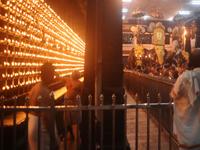 Other festivals that are conducted in Guruvayoor temple include Vishukkani in the month of April, Ashtami Rohini in the month of August or September, a part of the festival Chembai Sangeetha Mela and Ekadasi which is another very important festival celebrated for 30 days in the month of November or December. Though Ekadasi comes in every lunar fortnight and are 24 in number, the Vrishchika Ekadasi (Suklapaksha) has got special significance in Guruvayoor temple which falls in the auspicious Mandala season. The Chembai Sangeetha Mela festival is held to honour the popular music artist Shri Chembai Vaidyanatha Bhagavathar and the festival goes on for 11 days.
Other festivals that are conducted in Guruvayoor temple include Vishukkani in the month of April, Ashtami Rohini in the month of August or September, a part of the festival Chembai Sangeetha Mela and Ekadasi which is another very important festival celebrated for 30 days in the month of November or December. Though Ekadasi comes in every lunar fortnight and are 24 in number, the Vrishchika Ekadasi (Suklapaksha) has got special significance in Guruvayoor temple which falls in the auspicious Mandala season. The Chembai Sangeetha Mela festival is held to honour the popular music artist Shri Chembai Vaidyanatha Bhagavathar and the festival goes on for 11 days.How to reach Guruvayoor temple
Nearest Railway station - Guruvayoor railway station or Thrissur railway station (30km)
Nearest Airport - Cochin International Airport at Nedumbassery (75km)
Official website of Guruvayoor Devaswom - www.guruvayurdevaswom.org

I do so much appreciate your blog and all the wfodernul guidance you provide in photographing these types of scenes!! Did you also use your Sigma 20mm for these boys chanting? I am a relatively new photographer and am torn on what lens to get next having already a Sigma 50-150mm that I love. Your shots with the 20mm are so wfodernul. Thank you so much!